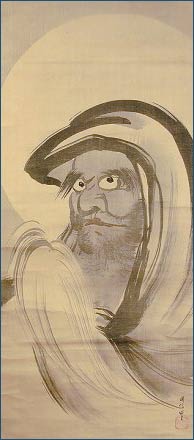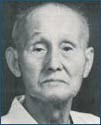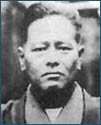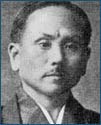Karate History

Bodhidharma (Daruma)
It is generally believed that the art of Karate-Do can be traced back to sixth century China. There, in the Mt. Sung Hennan Province, Dharma, and the founder of Zen, a sect of Buddhism composed a sutra or collection of precepts to promote the physical development of the monks and missionaries to help protect them from bandits and criminals.
The sutra developed by Dharma was called "Ekkin-Kyo," and it is believed that it evolved into Shaolin Temple Kenpo, " the way of Fists". Unfortunately, not much is known about this period in the history of Karate-Do and the relationship between Karate-Do and Shaolin Kenpo remains an ambiguous one.
In the ancient times there was no law prohibiting people from arming themselves. Weapons were standard in fighting, and most cultures have their own sword fighting system. Japan is renowned for its Samurai culture in the caste feudal system. The code of the Samurai was developed in the 18th century. The effective use of a sword was essential for a warrior. Samurai practiced with them and carried them in daily life as the symbol of their class.
In the later part of the 14th century however, the influence of the Chinese techniques on the development of Karate-Do becomes much more apparent. Under the ruler King Hassi of Chuzan of Okinawa, a policy was enacted prohibiting the people of Okinawa from arming themselves. In the 16th century, Japan's most southern clan, the powerful Satsuma clan, invaded Okinawa. They colonized Okinawa for use as a trading post with China. They also levied taxes on their goods. These events forced the people of Okinawa to secretly develop the so-called " Te". In addition to the weaponless fighting methods, Okinawans were using their farm tools for defense and developing fighting systems. These systems were referred to as "Te", meaning hands, techniques, and methods. In combination with the influence of Chinese techniques it was often called "Kara", referring to the Tang Dynasty of China, that there was a sense of more preciousness as today's foreign goods, and "Te", techniques.
In 1868, the Meiji restoration ended the Japanese feudal system. Japan opened free trade with western countries. Western culture, its industrial methods and educational system flourished in Japan in the late 1800's and early 1900's. This Meiji restoration brought the influence of western laws and values to Japan. The major reform was the abolition of the Samurai feudal system and the establishment of a centralized governing system. In short time, the new laws and customs were used to abolish the traditional carrying of the samurai sword. Hairstyles were also changed to a westernized cut. The Japanese no longer wore Samurai knots in their hair, and they were encouraged to wear western suit and dress.
In this era, in Karate, there were no specific styles, names, ranks or belts that are known today. Lacking formal names, people generally referred to various labels by putting the names of masters and Katas (as instructional methods) together, creating a label for the particular school. Similarly, distinctions of Karate were also named according to their distinct districts.
The three prominent centers of Karate in Okinawa were Shuri, Naha, and Tomari. You must understand that the teaching methods at the time were not like today's systematic rational methods. There were only a few Katas in each location, which were taught and developed. Only a small number of people took the private lessons. Later, Karate came to Tokyo, the capital of Japan, which recorded an exhibition in 1922 of Gichin Funakoshi. Funakoshi's Karate-Do later became the modern Shotokan system.
In this era many prominent Karate masters came to Japan, even though Okinawa was a part of Japan, Okinawa's history and its remote location resulted in the people of Okinawa being considered as colonized peasants and mistreated by most common Japanese. The most prominent Karate Masters came to Japan, among them were; Kenwa Mabuni, founder of Shito Ryu, and Chojun Miyagi, founder of Goju Ryu.
 |
 |
 |
 |
| Hironori Otsuka | Chojun Miyagi | Kenwa Mabuni | Gichin Funakoshi |
After the Karate Masters came to Japan in the 1920's, the present day style of karate developed; they have descended from the primitive Okinawan forms. It was not until the 1930's that a label was claimed and developed as a style, forced by the other established Japanese martial arts societies. Chojun Miyagi, a senior disciple of Kanryo Higaonna, first claimed a label to his style as Goju-Ryu (Hard Soft Style). Kenwa Mabuni named his style as Shito-Ryu. These two were very close friends and developed most of the technical bases of today's Karate.
The form of Kumite as practiced in today's Karate, was also influenced by other Japanese martial arts such as Jujitsu, Judo and Kendo masters. Until the late 1930's, Karate-Do practice emphasized only the Kata and its applications.
The term Karate-Do also was influenced by the Japanese Zen Buddhist sect and became "Kara" (empty) "Te" (techniques) and "Do" (The way of.). Dr. Jigoro Kano, the founder of Judo, established the current belt system during this era. Judo was a synthesis of Daito-Ryu and other Ju Jitsu. Dr. Kano established and created Ju (Soft) Do (The way of) from Jujitsu; these were methods for the development of ideology not just the development of technical skills.
Gichin Funakoshi aimed to teach only university students who were candidates for the governing leadership group. Funakoshi did not like his students to participate in tournaments.
That young Japanese group developed today's sparring methods and later developed the basis of today's tournament systems, not those of Okinawan residents' Karate instructors. Okinawan masters never even dreamed of competing with each other under established rules. They thought Karate techniques were so deadly that it would be impossible to hold any tournament. The first appearance of the modern version of a Karate tournament was held in the late 1950's in Japan. All Japan Collegiate Karate tournaments were the first tournaments ever held in Japan including Okinawa. It went on to develop Karate-Do worldwide.
